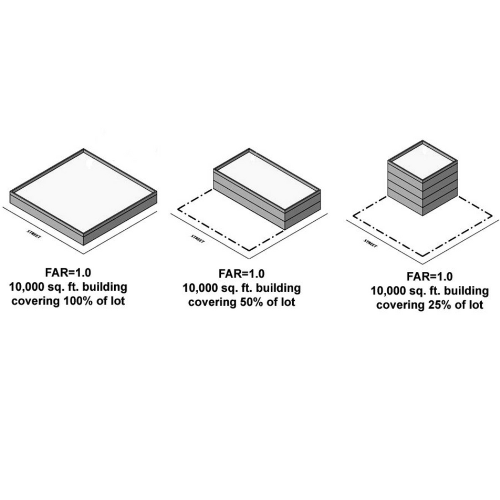Floor Area Ratio (FAR) is a critical component of the Land Development Code (LDC) in the City of Austin, Texas. The FAR is a zoning tool that regulates the maximum amount of floor area that can be constructed on a given lot. In the City of Austin, the FAR is determined by the zoning district in which the property is located.
In this blog post, we will provide a comprehensive overview of the FAR and its limitations, the available density bonuses or increases to FAR, and how they affect development in the city.
What is Floor Area Ratio (FAR)
The floor area ratio (FAR) is the principal bulk regulation controlling the size of buildings. FAR is the ratio of total building floor area in relation to the area of its zoning lot. Each zoning district has an FAR control which, when multiplied by the lot area of the zoning lot, produces the maximum amount of floor area allowable in a building on the zoning lot.
For example, on a 10,000 square-foot lot in a zoning district with a maximum FAR of 1.0, the floor area of a building cannot exceed 10,000 square feet. ( Article Source: Zoning Guide.indd (austintexas.gov) )
Image Courtesy:Zoning Guide.indd (austintexas.gov)
Limitations of FAR based on different zoning
Different zoning districts have different FARs. For example, in the Single-Family (SF-3) district, the FAR is limited to 0.4, while in the Central Business District (CBD), it can go as high as 15.0. The purpose of these limitations is to ensure that buildings are appropriately scaled to the surrounding area and that there is adequate space for amenities, landscaping, and open space.
However, the FAR has its limitations. While it can regulate the size and scale of a building, it does not necessarily control how the building is used or designed. For example, a developer could construct a building with a small footprint but with many stories that exceeds the FAR, creating a tall and narrow building that may not be suitable for the surrounding neighborhood.
Density Bonuses or Increases to FAR
The City of Austin offers density bonuses or increases to FAR to incentivize developers to provide public benefits, such as affordable housing, green space, or public art. These bonuses or increases to FAR allow developers to build more floor area than is typically allowed under the zoning district's FAR.
For example, under the Affordable Housing Density Bonus program, developers can receive an increase in FAR of up to 2.0 if they provide a certain percentage of affordable housing units in their development. Similarly, developers can receive density bonuses for providing green roofs or streetscape improvements.
Conclusion
In conclusion, the FAR is a critical tool in regulating the size and scale of buildings in the City of Austin. Different zoning districts have different FARs, and developers can receive density bonuses or increases to FAR to incentivize public benefits. While the FAR has its limitations, it remains an important zoning tool in regulating development and ensuring that buildings are appropriately scaled to their surroundings.
More Articles to read:


